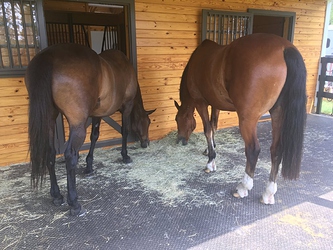My horse is at a new barn where horses are kept in sand paddocks. Hay is fed off the ground in nets over rubber mats. Feed is also fed off the ground. Once pastures are dry (late spring thru fall) horses will be out in bigger pastures for the day and then brought into paddocks with run ins for the evening. Would a sand preventative still be a good idea? And which one? Sand Clear fed once a month for a week, or Omega Horseshine or Chia seeds fed daily? How accurate is the “manure in water in a bag” test to check for sand?
I have lived in S. Florida my entire life and my horses have always lived on sand. I honestly never did anything special except maybe some sand clear every now and then if I remembered to buy some. Of course food up off the ground. I had 2 horses for 20yrs living like that with zero colic.
I’d go with the monthly SandClear.
Small expense for peace of mind.
No issues in Florida for seven years so far without any supplements.
Vet told me years ago that the SandClear is a waste of money and doesn’t do anything. Free-choice hay/grass keeps the gut moving and pushes out any sand they might ingest much better than any of the supplements.
Psyllium has proven to be far less effective at moving sand out than hay. Chia/flax would be the same, there’s not nearly enough of it you can safely feed to do that work.
Since your hay is being fed in a net over a mat, I think one of the biggest things you can do is to regularly sweep the mat clean so there is not lots of sand on the mat.
I think there are lots of horses who do just fine eating on sand and never have an issue.
Sandy South Carolina here. I feed hay over rubber mats under the barn overhang, which borders a largely bare sand paddock area. BUT - before each serving of hay gets put out, I use a leaf blower and remove all of the sand that has collected on the mats. It can be a lot of sand, particularly if the wind has been blowing towards that side of the barn. My guys love to lip up every last morsel, and I want to reduce concomitant sand ingestion.
Yes, to giving a sand prevention supplement. Manure test in a baggie of water is not reliable. I had one who showed no sand. Belly x-ray showed a “cinder block” of sand in her gut.
Are they sweeping the mats off daily?
I think they do sweep them but the sand gets right on there again from the horses’ feet, etc.
I’ve always been confused by the manure test in a baggie of water.
If there is sand in the bag, that is a GOOD THING, right? It means that the horse is effectively moving sand out of its gut.
I live in Florida. It is sand. My horses will eat sand. It is a fact of life here. In general they don’t eat much food off the ground; hay is fed in nets in large empty water troughs. They don’t tend to spill much grain, or show little interest in eating it off the ground anyway. Several of my fields don’t have much grass, and I rely on hay year round. I think the horses with grass who graze a lot tend to consume more sand than the dry-lot areas; cropping grass close to the ground ingests a lot more than picking stems of hay off the ground.
In any case, my horses get unlimited free choice hay, and I feed soaked beet pulp twice a day. With all that forage, (knock on wood) I’ve not had a sand colic in 10 years with 40 different horses in that time. University of Florida has proven forage is much more effective than any psyllium product in clearing sand from the gut.
Yeah, the baggie test shows sand being passed, which is a good thing.
What it doesn’t tell you is how much is in the horse. It can’t. There’s zero correlation between how much is in the baggie, and how much is in the horse.

